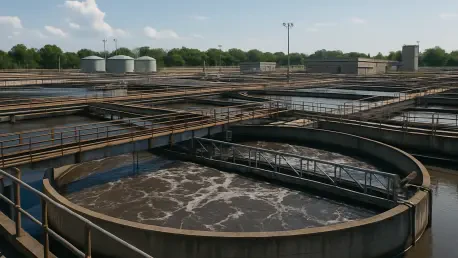Amid rising demands for innovative solutions in environmental engineering, researchers are venturing into plant-based technologies as a promising approach for wastewater treatment. A graduate student in environmental engineering, Nura Tung, spearheads groundbreaking research into Mobile Organic Biofilm (MOB) carriers to transform the wastewater treatment landscape. These carriers, devised by Nuvoda, consist of kenaf solids—comprised of small, porous granules sourced from fast-growing fiber crops. These unique granules serve as a habitat for bacteria adept at breaking down pollutants, including ammonia and phosphorus, known for their damaging effects on water systems when present in excessive concentrations. As the project unfolds, Tung and her mentor, Professor Eric Marchand, aim to leverage MOB’s ability to facilitate simultaneous ammonia and phosphate removal, ultimately streamlining wastewater purification processes. Conducted at the Truckee Meadows Water Reclamation Facility (TMWRF), this research could redefine conventional methodologies by fostering an integrated environment for vital pollutant-removing bacteria, traditionally cultivated separately due to their diverse habitat requirements.
Innovative Approach in Wastewater Treatment
The marriage of kenaf-based MOB carriers with wastewater technology represents an exciting evolution in treatment methodologies. Traditionally, wastewater plants struggle to optimize different bacteria due to their varied needs, requiring separate cultivation environments, which complicates the purification process. Tung’s exploration of kenaf material suggests a paradigm shift, indicating that this plant-based biofilm creates a unifying habitat conducive to nurturing both ammonia and phosphate-removing bacteria collectively. Early observations from experiments at TMWRF reveal promising results that could streamline and enhance sludge management. The advantage lies in the kenaf’s ability to support these bacteria more effectively, enabling pollutant breakdown while minimizing ecological footprint.
With the potential to improve plant operations, kenaf MOB carriers demonstrate an encouraging synergy between nature and technology. By harnessing natural biofilms, these carriers offer a sustainable alternative to synthetic treatments that often incur higher costs or have unwanted environmental impacts. The feedback from Tung’s ongoing studies invigorates interest in pioneering eco-friendly research and presents the scientific community with a tangible solution. This initiative forms part of a larger trend toward adopting sustainable measures, reflecting the broadening role of environmental engineering in conservation efforts. The results garnered from this project could set a precedent, motivating further innovations in plant-based, biofilm-focused technologies and fostering a deeper understanding of how nature-driven solutions can bolster industry standards.
Sustainable Solutions Yielding Promising Results
The implications of Tung’s research extend beyond the confines of scientific inquiry, emphasizing sustainable practices that often underpin community-centric conservation efforts. Her work aligns with the objectives of the Nevada Water Innovation Institute, which facilitates collaboration with local municipalities toward improved water resource management. The success of her 3-Minute Thesis presentation underscores the potential impact her findings could have in reshaping municipal approaches to wastewater treatment, heralding a fresh perspective on how science can intersect with public policy to yield transformative results. This endeavor embodies a commitment to sustainable development, promoting eco-friendly methodologies that resonate with broader environmental objectives.
Beyond the immediate scope, Tung’s project serves as a catalyst for interdisciplinary exploration, encouraging the integration of diverse fields within environmental engineering. Her vision remains fixed on identifying holistic frameworks that encompass ecological sustainability, which ultimately influences broader trends in water management. As the pursuit of viable solutions continues, the promise seen in kenaf MOB carriers instills optimism about the future of wastewater treatment innovations. The endeavor evokes a future where traditional and contemporary frameworks meld seamlessly, fostering enhanced environmental stewardship and resource efficiency, offering a viable roadmap for the industry at large.
Integrating Nature and Technology in Environmental Efforts
Faced with growing demands for creative solutions in environmental engineering, researchers are exploring plant-based strategies for wastewater treatment. Nura Tung, a graduate student in this field, leads pioneering research on Mobile Organic Biofilm (MOB) carriers with potential to revolutionize wastewater treatment methods. These carriers, developed by Nuvoda, are made from kenaf solids—small, porous granules derived from rapidly growing fiber crops. These granules provide a habitat for bacteria capable of degrading pollutants like ammonia and phosphorus, which can harm aquatic ecosystems in high concentrations. Working alongside Professor Eric Marchand, Tung aims to harness MOB carriers to remove ammonia and phosphate simultaneously, thereby refining purification processes. The research, taking place at the Truckee Meadows Water Reclamation Facility, has the potential to reform traditional practices by cultivating vital pollutant-removing bacteria together, something rarely done due to their diverse environmental needs.









